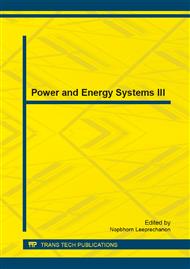[1]
A. Bhowmik, A. Maira, S. Halpin, J. Schatz, Determination of Allowable Penetration Levels of Distributed Generation Resources based on Harmonic Limit Considerations, IEEE Transactions on Power Delivery. Vol. 18, Nº 2, pp.619-624, April (2003).
DOI: 10.1109/tpwrd.2003.810494
Google Scholar
[2]
I. Bae, J. Kim, J.C. Kim, C. Singh, Optimal Operating Strategy for Distributed Generation Considering Hourly Reliability Worth, IEEE Transactions on Power Systems. Vol. 19, Nº 1, pp.287-292, February (2004).
DOI: 10.1109/tpwrs.2003.818738
Google Scholar
[3]
G. Celli, E. Ghiani, S. Mocci, F. PilIo, A Multiobjective Evolutionary Algorithms for the Sizing and Siting of Distributed Generation, IEEE Transactions on Power Systems. Vol. 20, Nº 2, pp.750-757, May (2005).
DOI: 10.1109/tpwrs.2005.846219
Google Scholar
[4]
R. Singh, S. Goswami, Optimum Siting and Sizing of Distributed Generations in Radial and Networked Systems, Electric Power Components and Systems, 37: 127-145, (2009).
DOI: 10.1080/15325000802388633
Google Scholar
[5]
G.N. Koutroumpezis, A.S. Safigianni, Optimum allocation of the maximum possible distributed generation penetration in a distribution network, Electric Power Systems Research 80 (2010) 1421–1427.
DOI: 10.1016/j.epsr.2010.06.005
Google Scholar
[6]
W. Prommee and W. Ongsakul, Optimal multiple distributed generation placement in microgrid system by improved reinitialized social structures particle swarm optimization, Euro. Trans. Electr. Power 2011; 21: 489–504.
DOI: 10.1002/etep.456
Google Scholar
[7]
N. Khalesi a, N. Rezaei a, M. -R. Haghifam, DG allocation with application of dynamic programming for loss reduction and reliability improvement, Electrical Power and Energy Systems 33 (2011) 288–295.
DOI: 10.1016/j.ijepes.2010.08.024
Google Scholar
[8]
L. Ochoa, A. Padilha, G. Harrison, Evaluating Distributed Time-Varying Generation through a Multiobjective Index, IEEE Transactions on Power Delivery. Vol. 23, Nº 2, pp.1132-1138, April (2008).
DOI: 10.1109/tpwrd.2008.915791
Google Scholar
[9]
R. K. Sing, K. Goswami, "Optimum Siting and Sizing of Distributed Generations in Radial and Networked Systems, Electric Power and Components and Systems, 37: 127-145, (2009).
DOI: 10.1080/15325000802388633
Google Scholar
[10]
T. Gözel, M. Hakan, An Analytical Method for the Sizing and Siting of Distributed Generators in Radial Systems, Electric Power Systems Research, 79(2009) 912-918.
DOI: 10.1016/j.epsr.2008.12.007
Google Scholar
[11]
W. Khattam, Y. Hegazy, M. Salama, Investigating Distributed Generation Systems Performance Using Monte Carlo Simulation, IEEE Transactions on Power Systems. Vol. 21, Nº 2, pp.524-532, May (2006).
DOI: 10.1109/tpwrs.2006.873131
Google Scholar
[12]
H. Gil, G. Joos, Models for Quantifying the Economic Benefits of Distributed Generation, IEEE Transactions on Power Systems, Vol. 23, Nº 2, pp.327-335, May (2008).
DOI: 10.1109/tpwrs.2008.920718
Google Scholar
[13]
E.D. Giannoulis, D.A. Haralambopoulos, Distributed Generation in an isolated grid: Methodology of case study for Lesvos – Greece, Applied Energy 88 (2011) 2530–2540.
DOI: 10.1016/j.apenergy.2011.01.046
Google Scholar
[14]
Emma M. Stewart, R. Tumilty, John Fletcher, Andrew Lutz, G. Ault, and Jim McDonald, Analysis of a Distributed Grid-Connected Fuel Cell During Fault Conditions, IEEE Transactions on Power Systems, Vol. 25, No. 1, February 2010, pp.497-505.
DOI: 10.1109/tpwrs.2009.2036776
Google Scholar
[15]
Lin jikeng, Wang Xudong and Qin Ling, Reliability evaluation for the distribution system with distributed generation, Euro. Trans. Electr. Power 2011; 21: 895–909.
DOI: 10.1002/etep.484
Google Scholar
[16]
F. Sheidaei, M. Shadkam, and M. Zarei, Optimal Distributed Generation allocation in Distribution Systems Employing Ant Colony to Reduce Losses, in Universities Power Engineering Conference. UPEC 43rd International, Padova, 2008, pp.1-5.
DOI: 10.1109/upec.2008.4651548
Google Scholar
[17]
B. Sookananta, P. Utaton, and R. Khongsila, Determination of Optimal Location and Sizing of Distributed Generation using Ant Colony Search, in Electrical Engineering/Electronics, Computer, Telecommunications and Information Technology (ECTI-CON), Chiang Mai, 2010, pp.814-817.
Google Scholar


